When it comes to animals, especially those that are home animals, there are a lot of restrictions on the food that they can eat in regard to fruits and vegetables. As someone who is looking to own their first dog in the future, food restrictions should be the top priority to educate myself to ensure my dog is nourished with nutrient-dense foods to support its health needs and keep any illnesses at bay.
What are some fruits and vegetables that dogs can and cannot eat? There are a number of fruits and vegetables that are allowed to be eaten and at the same time not allowed to be eaten, by dogs. It depends entirely on the fruit or vegetable, but it is very important to know what types of food to give to your dog.

I have compiled a list of the fruits and vegetables that they can or cannot eat and the rationale behind it. The list below makes it easier for you, whether you are an experienced owner or a new one.
Table of Contents
Safety Concerns with Fruits and Vegetables:
As someone who is looking for a new dog, I have been keen to observe a lot from those that already have one and keep asking myself questions regarding what can be eaten and the reasoning for it. Oftentimes, I see homeowners feed their pets table scraps or part of their afternoon snack.
Although these are foods safe for dogs, I also see the same homeowners to become adamant in the type of food that they give to their dogs. Sometimes, in fact, it can be unhealthy and dangerous for them.
Like a carnivorous animal, dogs are made to eat and consume meat, but having veggies occasionally is fine. In the list below, I share with you the fruits and vegetables that can be eaten so that you can take care of your pet.
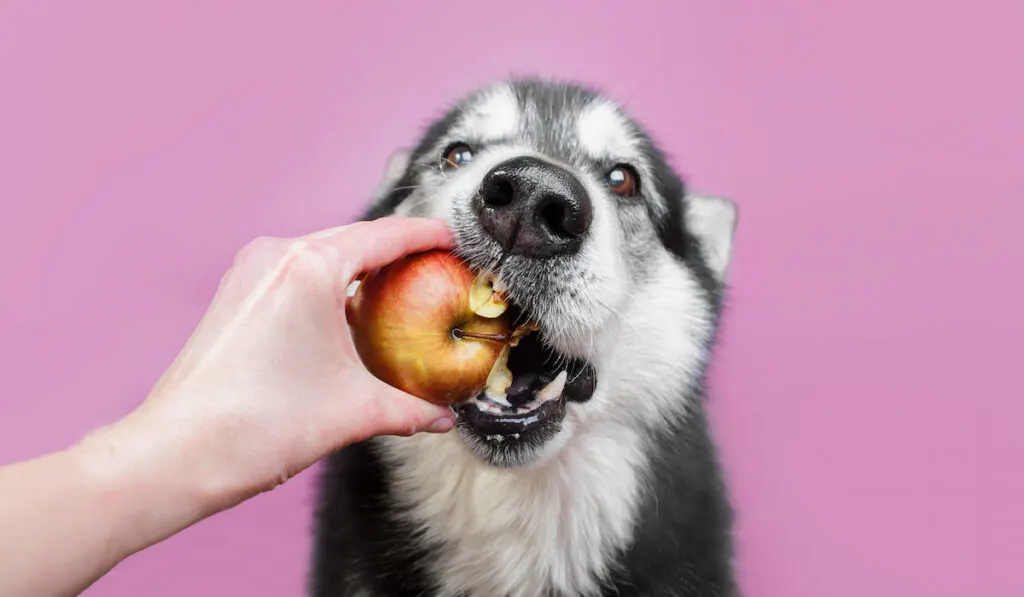
Fruits that Are Safe for Dogs to Eat
In a shortlist, here are the fruits that can be eaten:
- Apples
- Bananas
- Blueberries
- Cantaloupe
- Cranberries
- Cucumbers
- Mango
- Oranges
- Peaches
- Pears
- Pineapple
- Raspberry
- Strawberry
- Watermelon
Apples
Apples are an amazing and sufficient source of fiber, vitamin A, and vitamin C. since they are low in macronutrient value, like protein and fat, they are the perfect once-in-a-while treat for older dogs. Although they can still be given to younger pups, it is advised that apples are given to the older group. Most importantly, for digestion purposes, remove the seeds and core to make it easier for your dog to chew and swallow.
Bananas
Second, bananas serve as a low-calorie snack. One medium banana is around 100 calories, and you would only feed them to your dog in mini slices. They are high in potassium, fiber, and copper, and low on cholesterol and sodium. Just like apples, bananas are served as a treat and not as a main meal due to their high sugar content.
Blueberries
Third, blueberries, which might be the best one on this list. Unlike the bananas and apples, feeding blueberries in higher quantities does not have too many side effects. It is a superfood packed with antioxidants and phytochemicals that can prevent cell damage, and are extremely beneficial to your dog’s healthy diet.
Cantaloupe
Fourth on our list is the cantaloupe. It is packed with an amazing proportion of macro and micronutrients and low in calories. Further, it serves as a great source of water for your dog. Due to its high sugar content, however, this does not bode well for dogs that are overweight.
Cranberries
Fifth is cranberries. Just like any other treat, they should also be served in moderation. However, the benefits of cranberries, dried or otherwise, are extensive. They are extremely reached with nutrients that help benefit your dog’s immune system and assist with anti-inflammation.
Further, they improve cognitive function and can serve as preventive nutrients for allergies or skin issues. Being high in vitamin C and low in calories also makes cranberries very beneficial. It can, therefore, assists with dog’s bladder health, reduce plaque, lower the risk for diabetes and other heart diseases.
Cucumbers
Cucumbers are amazing if you want your dog to lose weight. What is special about them is that they have almost no caloric value and loaded with vitamin K and C, allowing the dogs’ energy levels to boost.
Mangoes
What makes the mango a unique treat is its 4 vitamin aspect, containing vitamin B6, C, A and E. Before feeding it to your dog, make sure to remove the hard pit to avoid choking.
Oranges
Oranges might face some disgust by other dogs due to their citrusy smell. Unlike humans, dogs can consume the flesh of orange if and only if it is in small quantities. They are high in vitamin C, and fiber, and can really benefit your dog’s overall health.
Peaches
Just like with any other treat, serve this one with moderation. They serve as a great source of vitamin A and can help infections. However, please cut around anything that can be choked on, like the pit, to avoid digestive issues. This rule is not the same for canned peaches. They are extremely high on sugar and should not be part of a dog’s healthy diet.
Pears
Pears are tenth on our list and are a great snack high in fiber and vitamin K. according to studies, it has been suggested that eating pears regularly for dogs can reduce the risk of having a stroke by 50%! As always, cut off the stem, remove the seeds and any hard portions of it(seeds and pit).
Pineapples
The pineapple is fine to be eaten as long as the skin is peeled off. The pineapple is the all-star of the list, being a tropic fruit that is full of nutrients and vitamins, minerals, as well as fiber. Further, it has bromelain, which makes it easier for dogs to absorb protein.
Raspberries
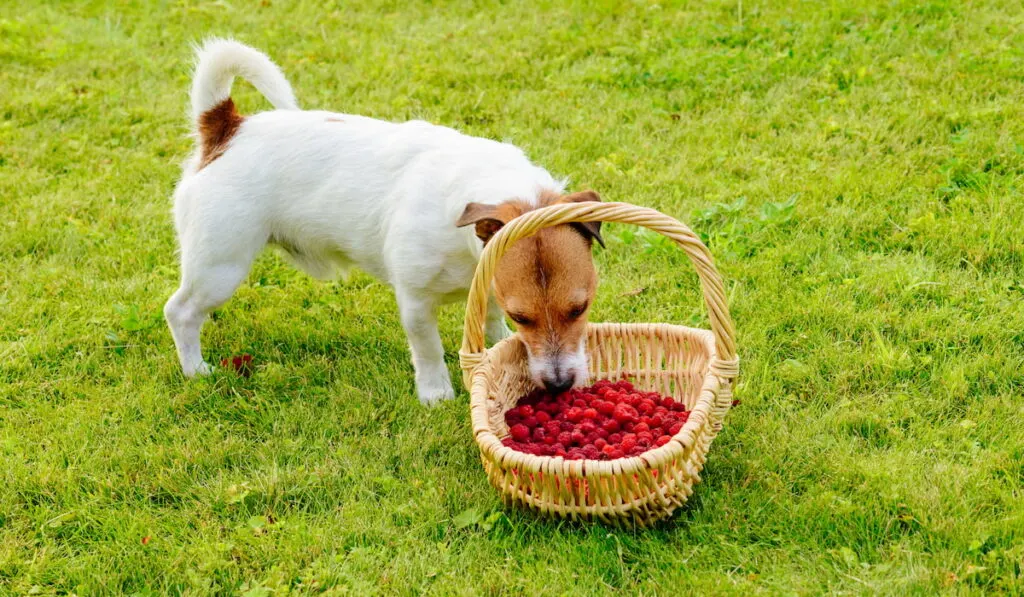
Raspberries contain a high amount of antioxidants that can be great for your dog. They are low in sugar and low in calories. They are also high in fiber and manganese. These are usually given to aging dogs, as they help with inflammation.
Strawberries
Last on our list that dogs can eat are strawberries. They are full of fiber and vitamin c and can help whiten your dog’s teeth! Due to their high sugar content, they cannot be eaten too much.
Fruits that Dogs Should Not Eat
In a shortlist, here are the fruits that cannot be eaten:
- Avocado
- Cherries
- Grapes
- Tomatoes
Avocadoes
The first on our list is avocadoes. Although avocadoes are great for us, the same does not bode well for these canines. The pit and skin of the fruit have persin, a toxin that causes dogs to vomit.
Persin is an antifungal compound that can be found in the leaves, skin, and seeds of an avocado. If your dog eats an avocado, it can be very costly for you. Once it is consumed, and the pit is swallowed, it is stuck in their intestinal tract. If this occurs, the only way to get it out is through surgical processes.
Cherries
Cherries contain cyanide. Cyanide is a huge aspect of this fruit that is not supposed to be given to dogs as any part of their diet. This disrupts cellular oxygen, making your dog’s cells not get enough oxygen. In fact, even in small doses, dogs can have dilated pupils and difficulty breathing.
Grapes
Grapes are the most dangerous of the list. Grapes are extremely toxic to dogs regardless of their dog’s sex and breed. In fact, they can lead to sudden kidney failure. The same rule follows for raisins.
The exact science or reason why a dog finds grapes toxic is not yet known. It is also not know how much of grapes would be detrimental to a dog’s health. In fact, some dogs may suffer more compared to different breeds. To be safe, please keep grapes out of sight and out of reach of a dog.
Tomatoes
The last on the list is the tomatoes. Unlike the grape, it is fine if a dog consumes this. If they have too much, they can get an upset stomach due to acidity.
This acidity comes from tomatine, a harmful toxin that can be deadly when consumed in a large quantity. However, the dogs need to consume an insane amount of tomatoes to feel the toxicity to be felt. Some benefits come with eating tomatoes, as well.
They have a good amount of fiber that can help digestion and maintain good blood sugar levels. However, what should be avoided is the green parts that have solanine. With too much of this, the dog can make them sick, so it is best to avoid them.
Vegetables that Are Safe For Dogs
- Broccoli
- Brussel sprouts
- Carrots
- Celery
- Green Beans
- Peas
- Spinach
Broccoli
Like fruits, it is best to give it in moderation. It is high in fiber and vitamin C. However, cut off the stalks since it has caused choking in other dogs before. In moderation, broccoli is great for dogs. It is low in calories and a great source of iron and potassium.
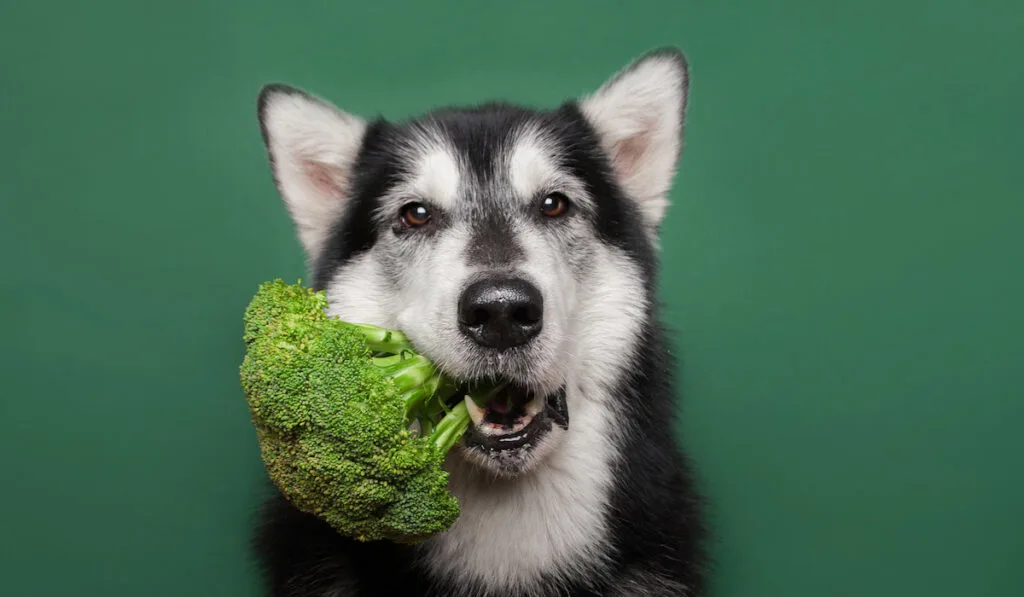
Brussel sprouts
They have a plentiful amount of nutrients that are extremely beneficial to both dogs and humans. Without serving them in moderation, they can cause a lot of gas. They are rich in fiber and antioxidants, helping reduce inflammation and “cleansing” the dog. Further, they improve blood circulation and have vitamins that can help your dog’s immune system and bone health.
Carrots
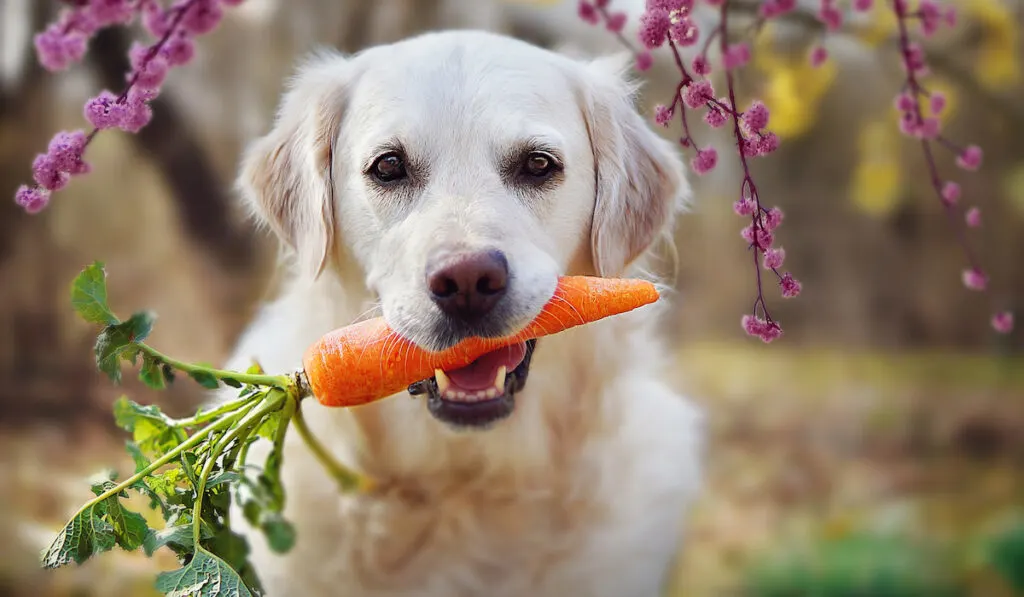
Carrots are low calories and very high in fiber. Further, crunching on the carrot is great for a dog’s oral health. It also contains important vitamins like beta carotene, later on, converted to potassium and vitamin K. However, each dog will have their own preference. If they like it raw, that is fine. If they liked it cooked, that is fine as well. Cooking carrots do not decrease their nutritional value.
Green Beans
Regardless of how they are cooked, green beans can be fed to dogs. They are low in calories, packed with vitamins, and high in fiber. The only thing to look out for is the canned products. This is because they have high salt content.
What is really awesome about this vegetable is that they also contain omega-3 fatty acids and iron–and dogs seem to love their taste. Recently, green beans have been in discussion as a treat to help dogs lose weight.
The gist of the diet is that it makes the dogs feel full despite not having such high caloric content. This, in turn, can then be helpful for more overweight dogs looking to enjoy walks and hikes more often.
Peas
As the green beans, any form of peas is fine to be given to your canine as long as it is in moderation. Also similar to the green beans are their benefits–fiber and vitamins–along with high protein and minerals. As an extra note, avoid canned products for their sodium content. They are a good source of Vitamin A, K, and B.
Further, they have huge content in iron, zinc, and magnesium, as well as protein and fiber. What makes peas particularly special, however, is that they contain lutein, an anti-oxidant great for skin and eye health.
However, do not give peas to dogs with kidney issues due to their purine content. Purine produces uric acid that is hard to filter through kidneys thus causing stones and other terrible medical conditions.
Spinach
The last on our list is the spinach. This vegetable is the least helpful to feed your dog. It contains vitamins A, B, K, and C. It also has roughage, which stimulates the digestive tract.
Although they can eat it, spinach has oxalic acid, blocking your canine’s ability to absorb calcium and lead to kidney damage.
Vegetables that Dogs Should Not Eat:
- Onions
- Mushrooms
- Asparagus
- Tomatoes
- Garlic
- Rhubarb
- Chives
Onions
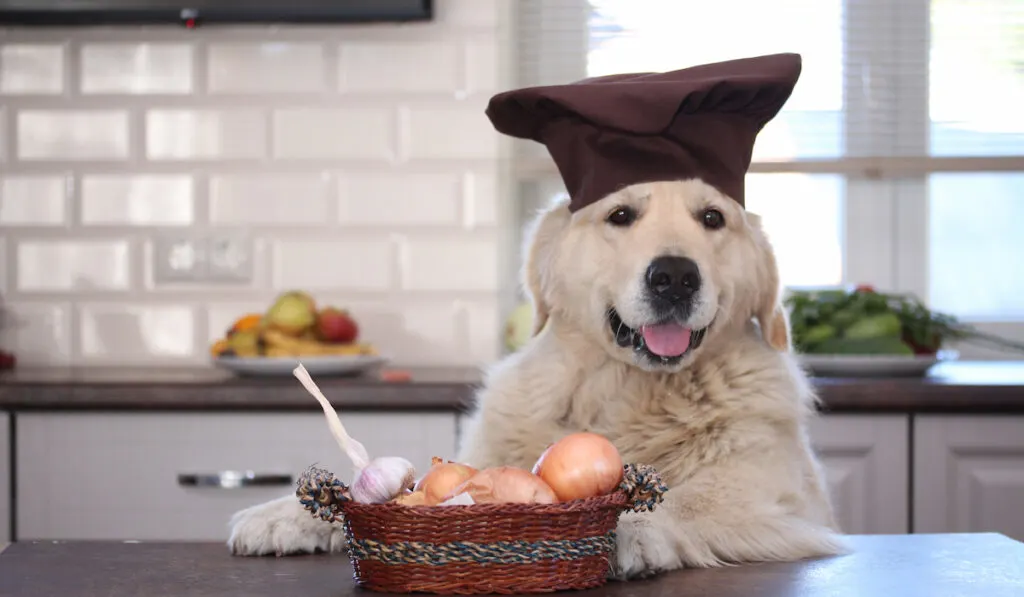
This is the deadliest that you can give your dog. Onions, like leeks and chives, are part of a plant family called Allium. Allium turns out to be very poisonous to most pets. The onions can cause your dog’s blood cells to rip, and in turn, cause vomiting, stomach pain, and diarrhea.
Mushrooms
This is the vegetable with the least amount of risk. As long as you’re dog is avoiding wild mushrooms, then it should be fine. There have been cases, however, of dogs eating toxic mushrooms that have led to death.
Due to this, consult veterinarian as soon as possible if your dog has consumed a wild mushroom. This will be more of a preventative measure rather than an active cure.
Asparagus
This one is the most useless vegetable that can be eaten. If you give it raw, it cannot be eaten. If you give it cooked, it loses its nutrient value. Opt for another vegetable or fruit instead.
Tomatoes
The green portion of the tomato or the green kind is unsafe for dogs because of the toxic substance called solanine. Although it is not as fatal as the others on the list, the effects on dogs can only be apparent if they eat large portions of tomatoes, it is best to keep them away in your dog’s diet.
Garlic
Garlic belongs to the Allium family which is very potent than onions and chives. It is poisonous to dogs (even cats!). Garlic is a very important ingredient in so many dishes and as a guide, 15 to 30 grams of garlic per kilograms of body weight is when you can see an impact on your dogs’ health. Again, better to be safe than sorry!
Rhubarb
Rhubarb contains oxalic acid which can result in major health deficits if your dog ingests it. When consumed, oxalic acid can cause kidney failure or vomiting in your dogs, so it is best to avoid this toxic plant as much as possible. The only thing dangerous about this plant is the leaves because they are the only part of the plant that contains oxalic acid. The stem, however, does not, so eating won’t be bad at all.
Chives
Just like garlic and onion on this list, chives belong to the Allium family. When eaten, your dog may experience some uncomfortable symptoms such as diarrhea and nausea. The reason why chives are so detrimental to your dogs’ health is that they have organosulfides, which is poisonous to your dogs’ digestive system.
Now that you have in hand an in-depth guide on the types of fruits and vegetables you can give to your dog, it is best that you help them maintain a healthy eating lifestyle. Remember to look out for those poisonous rhubarb leaves, but be sure to give them blueberries and bananas when you can. Not only will your dog love having a happy stomach, but you will appreciate not having a visit to the emergency room.
